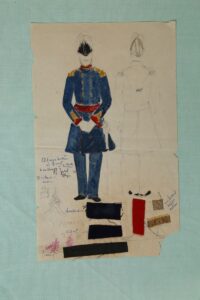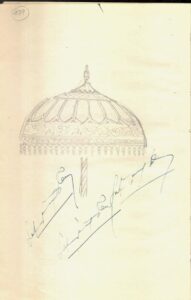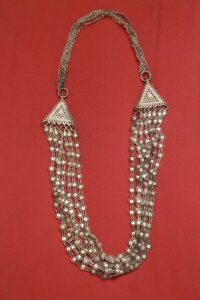Exhibition showcases costumes, jewellery used in Hindi film Shatranj Ke Khilari
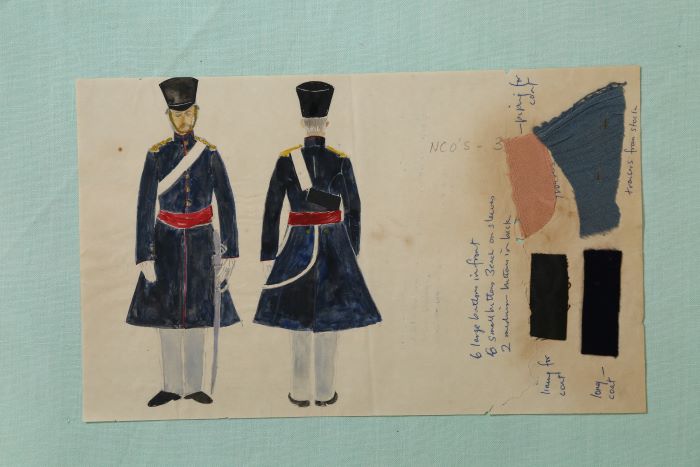
Costume drawings for Shatranj Ke Khilari
Rajkumari Sharma Tankha
As part of the birth centenary celebrations of noted film director Satyajit Ray, a one-of-its-kind exhibition to celebrate the fabric design heritage and related crafts of our country is being held at India International Centre (IIC) in New Delhi. Titled A King’s Gambit, the exhibition showcases a wide range of achkans, angrakhas, jamas, pyjamas, shararas, ornate cholis, turbans, pagris, silver ornaments, also footwear, worn in Awadh during the last days of the poet-king Wajid Ali Shah’s rule as shown in Hindi film Shatranj Ke Khiladi. The film, produced by Suresh Jindal and directed by Ray, was based on the book by the same name by Munshi Premchand.
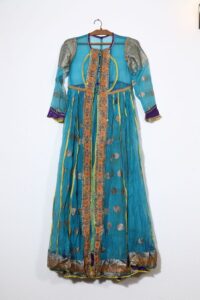
Costume (left) & costume design from Shatranj Ke Khilari
The costumes belong to Jindal’s personal collection. Apart from the outfits worn by the beleaguered poet-king, the exhibition has outfits that Lt General Sir James Outram, Captain Weston and Doctor Fayrer wore. “Since the film was set in winters, outfits were made in a variety of warm fabrics like velvet, brocade, silk and wool,” says Jindal, informing that the crew did a lot of research and ground work to procure information about the kind of clothes worn – fabrics and their colours, often visiting Hyderabad, Lucknow and Kolkata, not just to procure the fabric but for a detailed research to understand the times gone by.
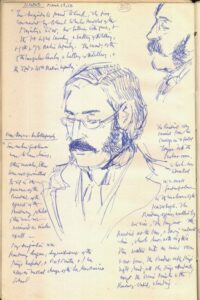
Pages from Satyajit Ray’s own notes and sketches
“Our primary resources were the Salar Jung Museum and Falaknuma Palace of the Nizams in Hyderabad and the City Palace Museum in Jaipur,” informs Jindal. Archival images available at the erstwhile Bourne & Shepherd Photographic Studio in Kolkata and the oil painting of Wajid Ali Shah at the Victoria Memorial were other resources that the filmmakers relied on. “Shah’s physical appearance in the film is drawn heavily from this oil painting,” says Jindal. Exhibition curator Indrani Majumdar says Ray also drew from the English translation of Abdul Halim Sharar’s Lucknow, The Last Phase of an Eastern Culture.
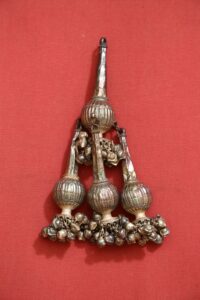
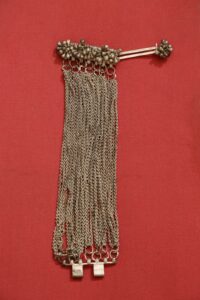
Different kinds of jewellery pieces used in Shatranj Ke Khilari
Reminiscing the painstaking research and labour that went into the creations of these costumes, Jindal informs that elaborate embroidery on Shah’s green robe (on display at the show) took three months to complete. The work was done by an Agra-based Master Craftsman, he says. Many garments like shawls were donated by the Thakur families of Kolkata for who had preserved these as their family heirlooms.
The exhibition has on view stills from the film, letters exchanged by Ray and Jindal; sketches prepared for the dresses along with their fabric swatches as well as sketches of the jewellery by Manju Saraogi who fabricated the costumes for the film. Two volumes of kheror khata (cloth-bound notebook) digitised by the National Digital Library of India are also exhibited as is the crown worn by the king of Awadh. Interestingly, Ray designed this crown.
The costumes will go back to Jindal’s cupboards once the show closes. “These costumes have a lot of historical value. We used finest of silks and hired expert karigars to turn out these intricate designs. I doubt if such karigari is even available now. So, after the film was over, I preserved them as mementos of the great karigari,” he says. “They need a lot of care, including regular sunshine to protect these costumes. To keep bad odour pests at bay, I place small holed boxes containing kapoor (camphor used in pooja) in cupboards,” informs Jindal, adding that he has no plan to auction these garments, “though I may just hand these over to some archives”.
The show is on till November 5 (11am – 7pm)
at Art Gallery Kamaladevi Complex, IIC


